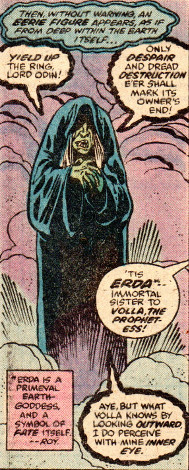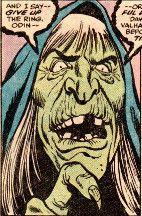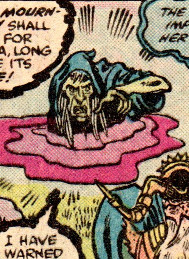 ERDA
ERDA  ERDA
ERDA
Real Name: Erda
Identity/Class: Extradimensional (Asgardian goddess)
Occupation: Earth goddess
Group Membership: Asgardian gods
Affiliations: Odin
Enemies: None revealed
Known Relatives: Volla (sister)
Aliases: None (see comments)
Base of Operations: Unrevealed (presumably somewhere associated with Asgard)
First Appearance: (Wagner's Alberich) Das Rhinegold
(The Rhinegold), the first of four parts in the opera "Der
Ring Des Nibelung" (The Ring of the Nibelung) opera (September 22, 1869);
(Marvel's Erda) Thor I#295 (May, 1980)
 Powers/Abilities: As an Asgardian goddess, Erda presumably had some degree of superhuman strength, stamina, durability, and longevity.
Powers/Abilities: As an Asgardian goddess, Erda presumably had some degree of superhuman strength, stamina, durability, and longevity.
She can apparently teleport herself, appearing from mists/smokes as if emerging from the Earth (perhaps just meaning below the ground, as I believe she emerged on Asgard) and vanishing through a magical portal.
Via her owner "inner eye," Erda could sense certain truths; she apparently had some degree of clairvoyance and possibly precognition.
The extent/limitations of all of her abilities are unrevealed.
Height: Unrevealed (she is not shown alongside anyone)
Weight: Unrevealed
Eyes: Unrevealed (she has pinpoint pupils, with no obvious iris in her sole appearance)
Hair: White
History:
(Thor I#295 (fb) - BTS) - As a primeval goddess, Erda is believed to predate Odin.
(Thor I#295 (fb)) - When Odin considered refusing to deliver the Rhinegold Ring (aka the Ring of the Nibelung -- which he had just claimed from Alberich -- to Fafnir and Fasolt in order to gain the return of Idunn, Erda suddenly appeared, as if from deep within the Earth itself. She warned Odin to yield up the ring, as only despair and dread destruction would ever mark it's owner's end.
When Odin recognized her as Volla's sister, Erda explained that while Volla knew by looking outward, she perceived with her own inner eye.
After repeating her instruction to Odin to give up the ring or a mournful day would dawn for Valhalla long before its time, she opened another portal through which she vanished.
Noting she had warned Odin well, she noted that she must depart, and she opened a portal and vanished.
(Thor I#295 (fb) - BTS) - Though sorely tempted by the Ring, Odin surrendered it to the giants, after which they returned Idunn.
Comments: <This version/incarnation> Created by Richard Wagner;
adapted by Roy Thomas, Keith Pollard, and Chic Stone.
Erda appears for a total of three panels in her sole appearance.
An editorial note explains that Erda is a primeval Earth goddess and a symbol of fate itself.
Erda was based on the character from Richard Wagner's Das
Rheingold (The Rhinegold), the first of four parts in the opera "Der
Ring Des Nibelung" (The Ring of the Nibelung) opera.
In that story, Erda
is considered a primeval Earth goddess older than Odin, and some
sources say she is confused with Jord (or would be pronounced more like
"Yord" in the Norse languages).
Here's some big information spelled out in Die Walkure not covered in the Thor comic (and thus not part of continuity):
Wotan explains his problems: troubled by the warning delivered by Erda (at the end of Das Rheingold),
he had seduced the earth-goddess to learn more of the prophesied doom;
Brünnhilde was born to him by Erda. He raised Brünnhilde and eight
other daughters as the Valkyries, warrior maidens who gather the souls
of fallen heroes to form an army against Alberich. Valhalla's army will fail if Alberich should ever wield the ring, which is in Fafner's possession. The giant has transformed himself into a dragon, lurking in a forest with the Nibelung treasure.
Wotan cannot wrest the ring from Fafner, who is bound to him by
contract; he needs a free hero to defeat Fafner in his stead. But as
Fricka pointed out, he can create only thralls (i.e. servants) to
himself. Bitterly, Wotan orders Brünnhilde to obey Fricka and grant
victory to Hunding in his battle with Wotan's beloved son Siegmund.
You can Google it for more information.
According to Wikipedia, The Ring of the Nibelung comes, in a very general way, from the old Norse/Germanic legend of the Nibelungenlied ("The Song of the Dwarves").
Some sources describe Erda as another name for Urd (or Urdr; aka Clotho and Klothos), the spinner (and representative of the past) of the Norns/Fates.
However, in the comics, Erda as described specifically as the sister of Volla (aka Fulla; with Volla being her High German name, and Fulla her name in Old Norse), who is a prophetess dwelling in Hel who foretold the coming of Ragnarok. Fulla is the servant of Frigg (Frigga) some sources, and apparently her sister in others. That's further complicated as Frigga was a distinct goddess from Freya/Freyja in Marvel up until most recently, when they were retconned into a single goddess.
This stories were among those told to Thor by the Eye of Odin, and the events therein, particularly the origins of the current Odin incarnation, have been called into question.
Profile by Snood.
CLARIFICATIONS:
Erda should be distinguished from:
images: (without ads)
Thor I#295, pg. 15, panel 1 (full);
panel 2 (face);
panel 3 (vanishing)
Appearances:
Thor I#295 (May, 1980) - Roy Thomas (writer/editor), Keith Pollard (penciler), Chic Stone (inker), Jim Shooter (consulting editor)
First Posted: 01/29/2018
Last updated: 01/29/2018
Any Additions/Corrections? please let me know.
Non-Marvel Copyright info
All other characters mentioned or pictured are ™ and
© 1941-2099 Marvel Characters, Inc. All Rights Reserved. If you
like this stuff, you should check out the real thing!
Please visit The Marvel Official Site at: http://www.marvel.com
Special Thanks to www.g-mart.com for hosting the Appendix, Master List, etc.!